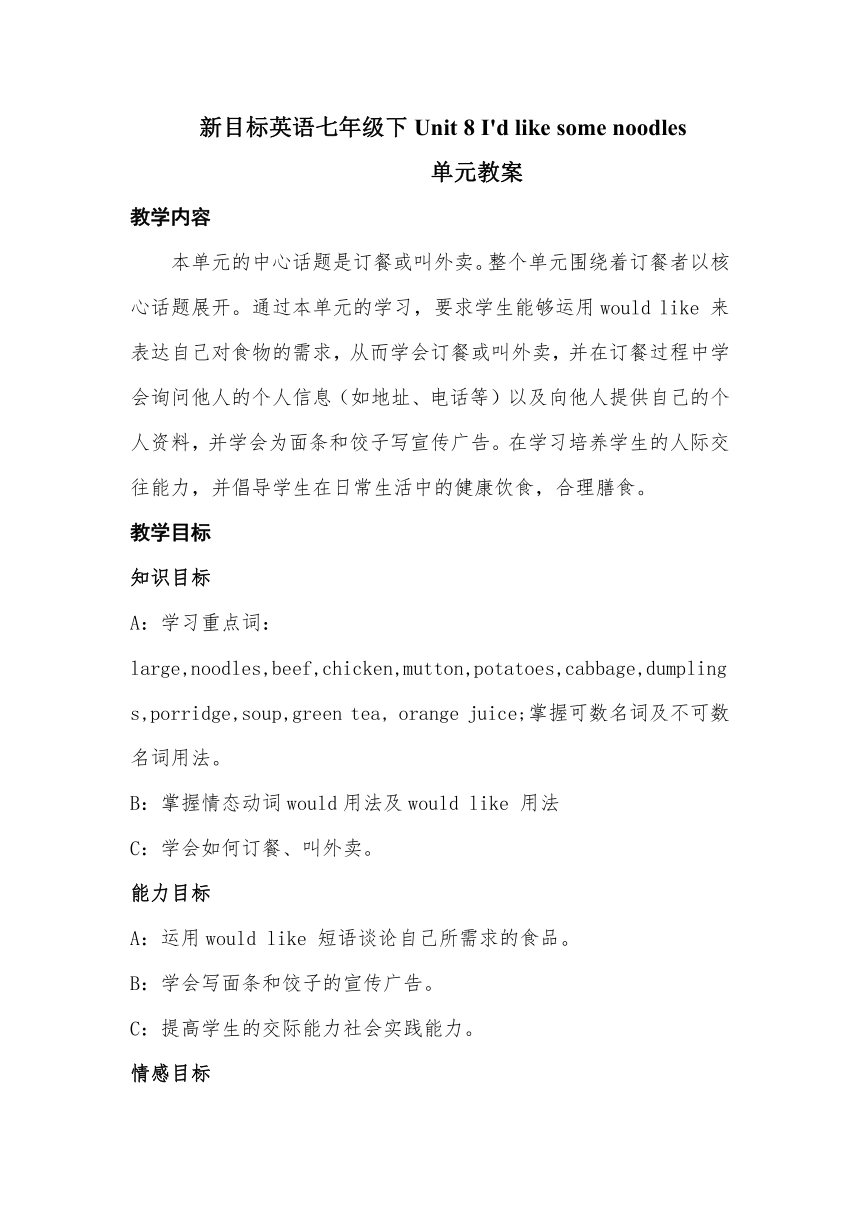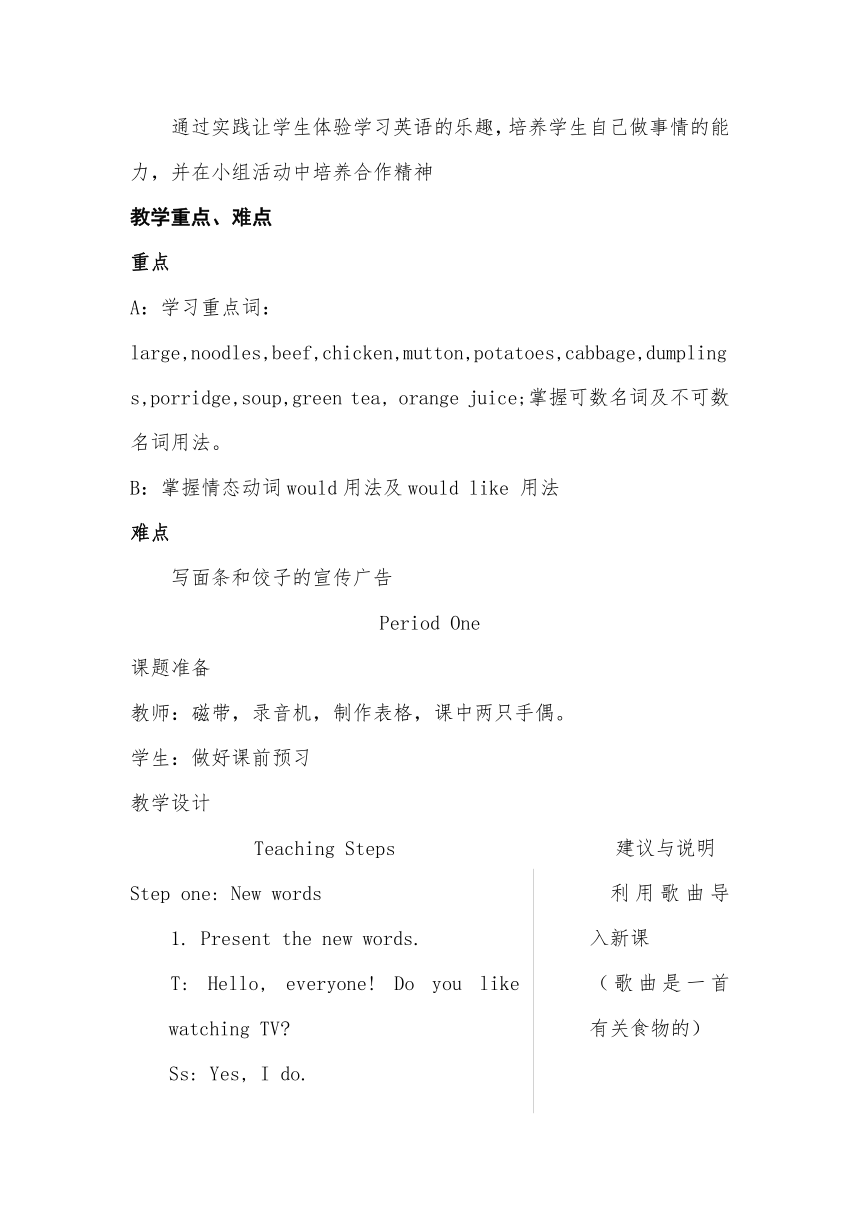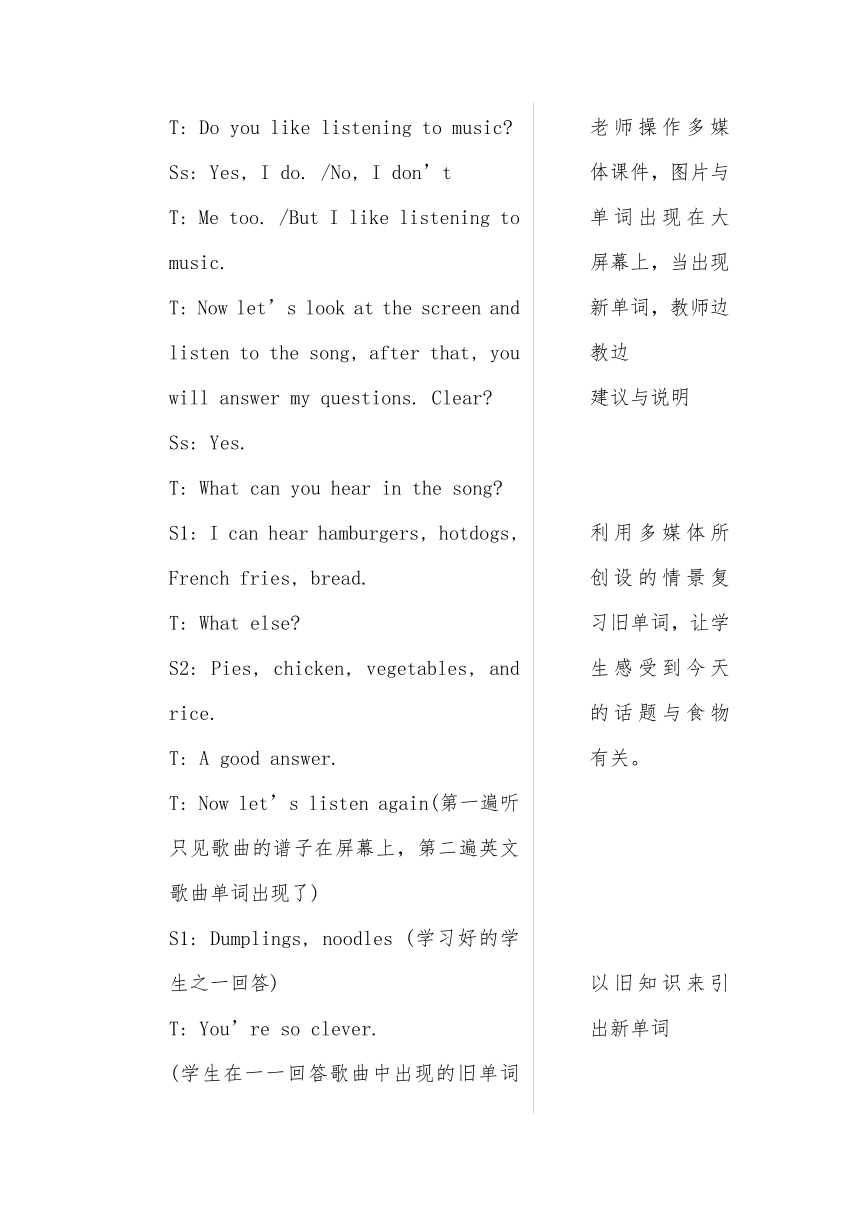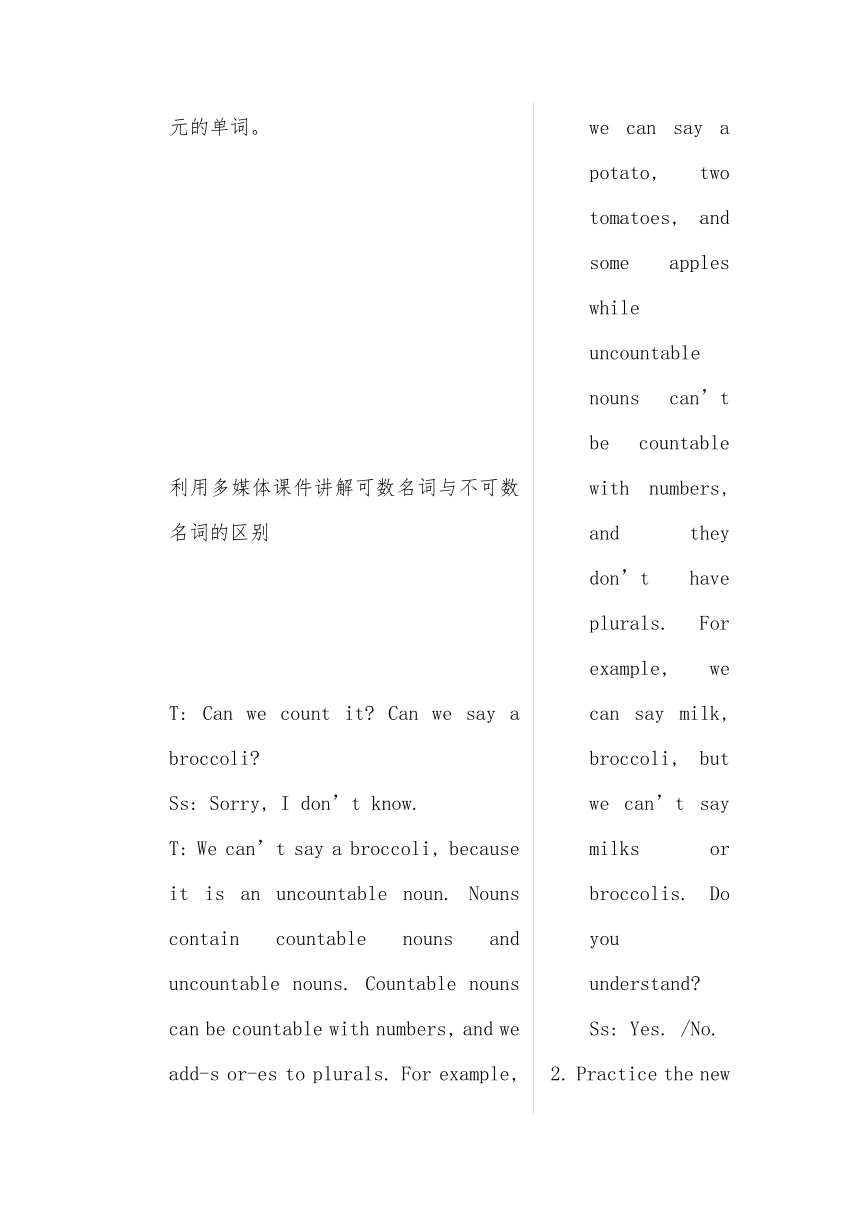七年级下Unit 8 I’d like some noodles单元教案[下学期]
文档属性
| 名称 | 七年级下Unit 8 I’d like some noodles单元教案[下学期] |  | |
| 格式 | rar | ||
| 文件大小 | 13.6KB | ||
| 资源类型 | 教案 | ||
| 版本资源 | 人教新目标(Go for it)版 | ||
| 科目 | 英语 | ||
| 更新时间 | 2009-05-05 08:47:00 | ||
图片预览





文档简介
新目标英语七年级下Unit 8 I'd like some noodles
单元教案
教学内容
本单元的中心话题是订餐或叫外卖。整个单元围绕着订餐者以核心话题展开。通过本单元的学习,要求学生能够运用would like 来表达自己对食物的需求,从而学会订餐或叫外卖,并在订餐过程中学会询问他人的个人信息(如地址、电话等)以及向他人提供自己的个人资料,并学会为面条和饺子写宣传广告。在学习培养学生的人际交往能力,并倡导学生在日常生活中的健康饮食,合理膳食。
教学目标
知识目标
A:学习重点词:large,noodles,beef,chicken,mutton,potatoes,cabbage,dumplings,porridge,soup,green tea, orange juice;掌握可数名词及不可数名词用法。
B:掌握情态动词would用法及would like 用法
C:学会如何订餐、叫外卖。
能力目标
A:运用would like 短语谈论自己所需求的食品。
B:学会写面条和饺子的宣传广告。
C:提高学生的交际能力社会实践能力。
情感目标
通过实践让学生体验学习英语的乐趣,培养学生自己做事情的能力,并在小组活动中培养合作精神
教学重点、难点
重点
A:学习重点词:large,noodles,beef,chicken,mutton,potatoes,cabbage,dumplings,porridge,soup,green tea, orange juice;掌握可数名词及不可数名词用法。
B:掌握情态动词would用法及would like 用法
难点
写面条和饺子的宣传广告
Period One
课题准备
教师:磁带,录音机,制作表格,课中两只手偶。
学生:做好课前预习
教学设计
Teaching Steps 建议与说明
Step one: New words
1. Present the new words.
T: Hello, everyone! Do you like watching TV
Ss: Yes, I do.
利用歌曲导入新课
(歌曲是一首有关食物的)
T: Do you like listening to music
Ss: Yes, I do. /No, I don’t
T: Me too. /But I like listening to music.
T: Now let’s look at the screen and listen to the song, after that, you will answer my questions. Clear
Ss: Yes.
T: What can you hear in the song
S1: I can hear hamburgers, hotdogs, French fries, bread.
T: What else
S2: Pies, chicken, vegetables, and rice.
T: A good answer.
T: Now let’s listen again(第一遍听只见歌曲的谱子在屏幕上,第二遍英文歌曲单词出现了)
S1: Dumplings, noodles (学习好的学生之一回答)
T: You’re so clever.
(学生在一一回答歌曲中出现的旧单词老师操作多媒体课件,图片与单词出现在大屏幕上,当出现新单词,教师边教边
建议与说明
利用多媒体所创设的情景复习旧单词,让学生感受到今天的话题与食物有关。
以旧知识来引出新单词
领读)
Now look at the picture, what are these in Chinese
Ss:饺子,面条
T: Yes, they are dumplings, Read after me, Dumplings, D-U-M-P-L-I-N-G-S.
T: Do you like eating dumplings
Ss: Yes, I do. /No, I don’t
(T teach “noodles” in the same way)
Step Two: Grammar
1. Present the countable nouns and uncountable nouns.
T: Look, How many dumplings are there Let’s count. One, two……
Ss: Five
T: Right, what are those
(Show a picture of two potatoes)
Ss: They ate potatoes.
T: How many potatoes are there
Ss: Two.
T: What about this one
Ss: It’s broccoli.
建议与说明
本单元的单词基本都是有关食物的单词,根据这一特点,教师用图片来集中学习整个单元的单词。
利用多媒体课件讲解可数名词与不可数名词的区别
T: Can we count it Can we say a broccoli
Ss: Sorry, I don’t know.
T: We can’t say a broccoli, because it is an uncountable noun. Nouns contain countable nouns and uncountable nouns. Countable nouns can be countable with numbers, and we add-s or-es to plurals. For example, we can say a potato, two tomatoes, and some apples while uncountable nouns can’t be countable with numbers, and they don’t have plurals. For example, we can say milk, broccoli, but we can’t say milks or broccolis. Do you understand
Ss: Yes. /No.
2. Practice the new words.
T: Good look at the pictures and fill in the chart according to the category.
(Show the students some pictures of food, vegetables meat and drinks)
Food Vegetable Meat Drink
… … … …
… … … …
建议与说明
利用多媒体课件中直接呈现语法
利用多媒体课件,以单词归类的形式操练,巩固单词
(Teach students new words “beef, mutton, cabbage, potato, juice, porridge, green tea, rice, soup and fish”)
3. Practice the grammar
T: Now let’s have a discussion in groups of four. Look at the pictures and fill in the chart, then tell us what kind of nouns these things are.
countable nouns uncountable nouns
… …
(Give each groups a chart; ask them to finish it first and then each group gives a report)
T: Now, Let’s see the results.
Step Three: Now drills 1.Prsen new drills
T: What kind of food would you like
S1: I’d like …
T: let Ss practice the drill.
T: What kind of vegetables would you like
S1: I’d like …
T: Now let’s look at the sentences and make a dialogue with you partners.
建议与说明
通过单词归类强化对可数名词和不可数名词的理解
利用多媒体课件中让学生两
A: What kind of would you like
B: I’d like …
2. Game time
T: Now let’s play a game, OK I have two new friends. (拿两个手偶放在手背后,然后拿出来问学生: What’s this )
Ss: It’s a tiger T: Do you like it
Ss: Yes, I do
(Show a duck in the same way)
T: Now let pass these animals when the music stop, you will make a dialogue
(让学生玩击鼓传花的游戏来练习口语练习新句型,以保证人人都开口说英语)
3. Present the drill “what kind of noodles would you like I’d like beef and tomatoes noodles”
T: Look at the screen. Where is it
Ss: It is a noodles house.
T: Now I work in a restaurant, welcome to our restaurant, I teach new words“special”
两对话操练新句型
建议与说明
利用多媒体课件创设一个餐馆的情景教句子和词组
“Special” means the thing which is very cheap.
T: Today, in my noodles house these are four special.
T asks Ss: what kind of noodles
Ss: beef and carrot. / Cabbage and chicken. /Onion and mutton. / Eggs and tomatoes.
4. Practice the drill
T: I think different people may have different tastes. So I’d like to know what kind of noodles you would like. Let’s do pair work one by one using these sentences.
Turn to page 47, let’s do activity 1b. Listen and check the noodles that the person orders.
(Play the tape for the students twice)
T: Now let’s check the answers.
5. Present the drill “what size bowl of noodles would you like ”
T: Look, I have three bowls of noodles here, a large one, a medium and a small one. I am hungry, so I would like a large bowl of
建议与说明
利用两两对话和听力形式操练巩固所学句型
Noodles. What size bowl of noodles would you like
S1: I would like a large one, too
S2: I’d like a …
(Ask four students to answer this question)
(Write “what size bowl of noodles would you like I’d like a large bowl of noodles.” on the black board)
5. Practice the drill.
T: A boy and a girl like noodles very much. So thy come to a noodles house one day. What do they order do you want to know Open your books on page 48. Let’s do activity 2a. Listen and check the names of the foods you hear below
(Play the tape for the students)
T: Ley’s check the answers.
Step four: Task
T: Now my house of noodles is very busy, so can you help me answers the phones for ordering food
Ss: Yes.
建议与说明
利用听力形式操练巩固所学句型
设计任务是学生学会用电话订餐
T: Now let’s work in pairs.
SA is a waiter in my restaurant.
SB telephones us to order some food.
(T gives Ss a piece of paper)
Order form
……
……
Step Five: summary
T: Today we have learned how to order food from a restaurant on the phone, I think we should eat healthier is the most important for us and health is everything.
(老师利用课件展开健康食物和不健康的食物,最后老师给学生展示一张人民币问学生钱和健康哪个更重要,然后布置家庭作业)
Home work
Health is very important; it is easy to have a healthy lifestyle, and it is important to eat a balanced diet Can you design a menu for the week
Ss: Yes.
建议与说明
在学生准备的过程中,课件展示订餐的过程,学生先看一遍,听一遍再准备
在课后最后利用课件进行德育培养
T: Let’s have a discussion in groups of four, First fill in the form and each group should give us a report, and give reasons for the menu
Breakfast Lunch Dinner
Monday … … …
Tuesday … … …
Wednesday … … …
Thursday … … …
Friday … … …
Saturday … … …
Sunday … … …
(本节课是本人上过的市级优质课一等奖的教案,如有不妥之处,还望专家指正)
建议与说明
Food
Fruits
Vegetable
Meat
Drink
单元教案
教学内容
本单元的中心话题是订餐或叫外卖。整个单元围绕着订餐者以核心话题展开。通过本单元的学习,要求学生能够运用would like 来表达自己对食物的需求,从而学会订餐或叫外卖,并在订餐过程中学会询问他人的个人信息(如地址、电话等)以及向他人提供自己的个人资料,并学会为面条和饺子写宣传广告。在学习培养学生的人际交往能力,并倡导学生在日常生活中的健康饮食,合理膳食。
教学目标
知识目标
A:学习重点词:large,noodles,beef,chicken,mutton,potatoes,cabbage,dumplings,porridge,soup,green tea, orange juice;掌握可数名词及不可数名词用法。
B:掌握情态动词would用法及would like 用法
C:学会如何订餐、叫外卖。
能力目标
A:运用would like 短语谈论自己所需求的食品。
B:学会写面条和饺子的宣传广告。
C:提高学生的交际能力社会实践能力。
情感目标
通过实践让学生体验学习英语的乐趣,培养学生自己做事情的能力,并在小组活动中培养合作精神
教学重点、难点
重点
A:学习重点词:large,noodles,beef,chicken,mutton,potatoes,cabbage,dumplings,porridge,soup,green tea, orange juice;掌握可数名词及不可数名词用法。
B:掌握情态动词would用法及would like 用法
难点
写面条和饺子的宣传广告
Period One
课题准备
教师:磁带,录音机,制作表格,课中两只手偶。
学生:做好课前预习
教学设计
Teaching Steps 建议与说明
Step one: New words
1. Present the new words.
T: Hello, everyone! Do you like watching TV
Ss: Yes, I do.
利用歌曲导入新课
(歌曲是一首有关食物的)
T: Do you like listening to music
Ss: Yes, I do. /No, I don’t
T: Me too. /But I like listening to music.
T: Now let’s look at the screen and listen to the song, after that, you will answer my questions. Clear
Ss: Yes.
T: What can you hear in the song
S1: I can hear hamburgers, hotdogs, French fries, bread.
T: What else
S2: Pies, chicken, vegetables, and rice.
T: A good answer.
T: Now let’s listen again(第一遍听只见歌曲的谱子在屏幕上,第二遍英文歌曲单词出现了)
S1: Dumplings, noodles (学习好的学生之一回答)
T: You’re so clever.
(学生在一一回答歌曲中出现的旧单词老师操作多媒体课件,图片与单词出现在大屏幕上,当出现新单词,教师边教边
建议与说明
利用多媒体所创设的情景复习旧单词,让学生感受到今天的话题与食物有关。
以旧知识来引出新单词
领读)
Now look at the picture, what are these in Chinese
Ss:饺子,面条
T: Yes, they are dumplings, Read after me, Dumplings, D-U-M-P-L-I-N-G-S.
T: Do you like eating dumplings
Ss: Yes, I do. /No, I don’t
(T teach “noodles” in the same way)
Step Two: Grammar
1. Present the countable nouns and uncountable nouns.
T: Look, How many dumplings are there Let’s count. One, two……
Ss: Five
T: Right, what are those
(Show a picture of two potatoes)
Ss: They ate potatoes.
T: How many potatoes are there
Ss: Two.
T: What about this one
Ss: It’s broccoli.
建议与说明
本单元的单词基本都是有关食物的单词,根据这一特点,教师用图片来集中学习整个单元的单词。
利用多媒体课件讲解可数名词与不可数名词的区别
T: Can we count it Can we say a broccoli
Ss: Sorry, I don’t know.
T: We can’t say a broccoli, because it is an uncountable noun. Nouns contain countable nouns and uncountable nouns. Countable nouns can be countable with numbers, and we add-s or-es to plurals. For example, we can say a potato, two tomatoes, and some apples while uncountable nouns can’t be countable with numbers, and they don’t have plurals. For example, we can say milk, broccoli, but we can’t say milks or broccolis. Do you understand
Ss: Yes. /No.
2. Practice the new words.
T: Good look at the pictures and fill in the chart according to the category.
(Show the students some pictures of food, vegetables meat and drinks)
Food Vegetable Meat Drink
… … … …
… … … …
建议与说明
利用多媒体课件中直接呈现语法
利用多媒体课件,以单词归类的形式操练,巩固单词
(Teach students new words “beef, mutton, cabbage, potato, juice, porridge, green tea, rice, soup and fish”)
3. Practice the grammar
T: Now let’s have a discussion in groups of four. Look at the pictures and fill in the chart, then tell us what kind of nouns these things are.
countable nouns uncountable nouns
… …
(Give each groups a chart; ask them to finish it first and then each group gives a report)
T: Now, Let’s see the results.
Step Three: Now drills 1.Prsen new drills
T: What kind of food would you like
S1: I’d like …
T: let Ss practice the drill.
T: What kind of vegetables would you like
S1: I’d like …
T: Now let’s look at the sentences and make a dialogue with you partners.
建议与说明
通过单词归类强化对可数名词和不可数名词的理解
利用多媒体课件中让学生两
A: What kind of would you like
B: I’d like …
2. Game time
T: Now let’s play a game, OK I have two new friends. (拿两个手偶放在手背后,然后拿出来问学生: What’s this )
Ss: It’s a tiger T: Do you like it
Ss: Yes, I do
(Show a duck in the same way)
T: Now let pass these animals when the music stop, you will make a dialogue
(让学生玩击鼓传花的游戏来练习口语练习新句型,以保证人人都开口说英语)
3. Present the drill “what kind of noodles would you like I’d like beef and tomatoes noodles”
T: Look at the screen. Where is it
Ss: It is a noodles house.
T: Now I work in a restaurant, welcome to our restaurant, I teach new words“special”
两对话操练新句型
建议与说明
利用多媒体课件创设一个餐馆的情景教句子和词组
“Special” means the thing which is very cheap.
T: Today, in my noodles house these are four special.
T asks Ss: what kind of noodles
Ss: beef and carrot. / Cabbage and chicken. /Onion and mutton. / Eggs and tomatoes.
4. Practice the drill
T: I think different people may have different tastes. So I’d like to know what kind of noodles you would like. Let’s do pair work one by one using these sentences.
Turn to page 47, let’s do activity 1b. Listen and check the noodles that the person orders.
(Play the tape for the students twice)
T: Now let’s check the answers.
5. Present the drill “what size bowl of noodles would you like ”
T: Look, I have three bowls of noodles here, a large one, a medium and a small one. I am hungry, so I would like a large bowl of
建议与说明
利用两两对话和听力形式操练巩固所学句型
Noodles. What size bowl of noodles would you like
S1: I would like a large one, too
S2: I’d like a …
(Ask four students to answer this question)
(Write “what size bowl of noodles would you like I’d like a large bowl of noodles.” on the black board)
5. Practice the drill.
T: A boy and a girl like noodles very much. So thy come to a noodles house one day. What do they order do you want to know Open your books on page 48. Let’s do activity 2a. Listen and check the names of the foods you hear below
(Play the tape for the students)
T: Ley’s check the answers.
Step four: Task
T: Now my house of noodles is very busy, so can you help me answers the phones for ordering food
Ss: Yes.
建议与说明
利用听力形式操练巩固所学句型
设计任务是学生学会用电话订餐
T: Now let’s work in pairs.
SA is a waiter in my restaurant.
SB telephones us to order some food.
(T gives Ss a piece of paper)
Order form
……
……
Step Five: summary
T: Today we have learned how to order food from a restaurant on the phone, I think we should eat healthier is the most important for us and health is everything.
(老师利用课件展开健康食物和不健康的食物,最后老师给学生展示一张人民币问学生钱和健康哪个更重要,然后布置家庭作业)
Home work
Health is very important; it is easy to have a healthy lifestyle, and it is important to eat a balanced diet Can you design a menu for the week
Ss: Yes.
建议与说明
在学生准备的过程中,课件展示订餐的过程,学生先看一遍,听一遍再准备
在课后最后利用课件进行德育培养
T: Let’s have a discussion in groups of four, First fill in the form and each group should give us a report, and give reasons for the menu
Breakfast Lunch Dinner
Monday … … …
Tuesday … … …
Wednesday … … …
Thursday … … …
Friday … … …
Saturday … … …
Sunday … … …
(本节课是本人上过的市级优质课一等奖的教案,如有不妥之处,还望专家指正)
建议与说明
Food
Fruits
Vegetable
Meat
Drink
同课章节目录
- Unit 1 Can you play the guitar?
- Section A
- Section B
- Unit 2 What time do you go to school?
- Section A
- Section B
- Unit 3 How do you get to school?
- Section A
- Section B
- Unit 4 Don't eat in class.
- Section A
- Section B
- Unit 5 Why do you like pandas?
- Section A
- Section B
- Unit 6 I'm watching TV.
- Section A
- Section B
- Review of Units 1-6
- Unit 7 It's raining!
- Section A
- Section B
- Unit 8 Is there a post office near here?
- Section A
- Section B
- Unit 9 What does he look like?
- Section A
- Section B
- Unit 10 I'd like some noodles.
- Section A
- Section B
- Unit 11 How was your school trip?
- Section A
- Section B
- Unit 12 What did you do last weekend?
- Section A
- Section B
